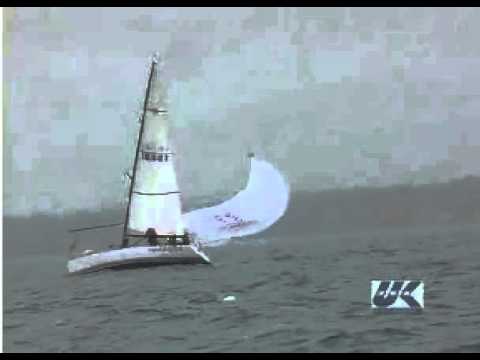
The Man OverBoard Quick Stop With Spinnaker – Part 2
Part 2 “Lessons Learned”
The early April Safety at Sea Seminar held at the US Merchant Marine Academy at Kings Point, New York, served up perfect conditions for practicing real-life man overboard drills. The sky was over cast, sleet mixed with rain while the wind blew between 15 and 30 knots. The first video in our series shows the perfect man overboard recovery technique when sailing with a spinnaker; this video, shows an unpracticed crew in stormy conditions. Everyone can learn from what they did right and not so right.
In the video the “victim” jumps off the transom without the crew being ready. The crew, caught unaware, struggles to free the spinnaker halyard. As they try to get it free the boat barrels away from the victim at 7.4 knots. 20 seconds later, when the boat is 75 yards away, the helmsman finally turns sharply up wind to slow down and keep from getting further away from the MOB. It takes another 10 seconds after the boat turns for the spinnaker to start coming down.
Notice how the boat immediately heels over as the helm is turned sharply. This will happen when the boat turns quickly; the crew must be warned to hold on. Don’t make a slow gentle turn. A sharp turn slows the boat quickly so that you don’t get too far away.
The next mistake is that the afterguy guy is released too much. Only ease it enough to move the pole to the headstay. Be careful not to let the pole smack the headstay. You could break the pole or the luff foil. Once the pole is at the headstay, cleat off the after guy. In the video the crew continues to release the afterguy, which allows the spinnaker to blow aft of the boat. This makes it harder for the crew to pull the sail down and get it under control. Watch them struggle. When the clew stays at the pole end, most of the spinnaker will fall on the deck.
It is a full minute and a half after the person went over the side that the boat tacks to come back to the victim and it is another minute-and-a-half to make contact with the MOB. Three minutes and 20 seconds to pick up a MOB is not terrible, but you can see how easy it is to get far away from the victim when the boat is traveling at high speeds. The further away you are, the easier it is to lose site of the person in the water. Moving at such speeds also negates your ability to throw flotation in the water and get it anywhere near the victim. Sailing fast is one more reason that everyone should be wearing PFDs.
Lessons learned from this video clip are for to always keep your spinnaker halyard ready to run. Never ease the afterguy so much that the clew of the spinnaker gets away from the pole end so that the chute will fall on deck. And a third lesson is don’t be afraid to use your engine for a MOB recovery. Once the lines are out of the water, don’t be concerned about the racing rules. Your primary goal is a successful recovery! This crew could have made up a lot of lost time if they simply turned their engine on and powered to windward after the spinnaker was recovered. That would have cut out all the time it took to sail closehauled on two tacks with just the mainsail.


